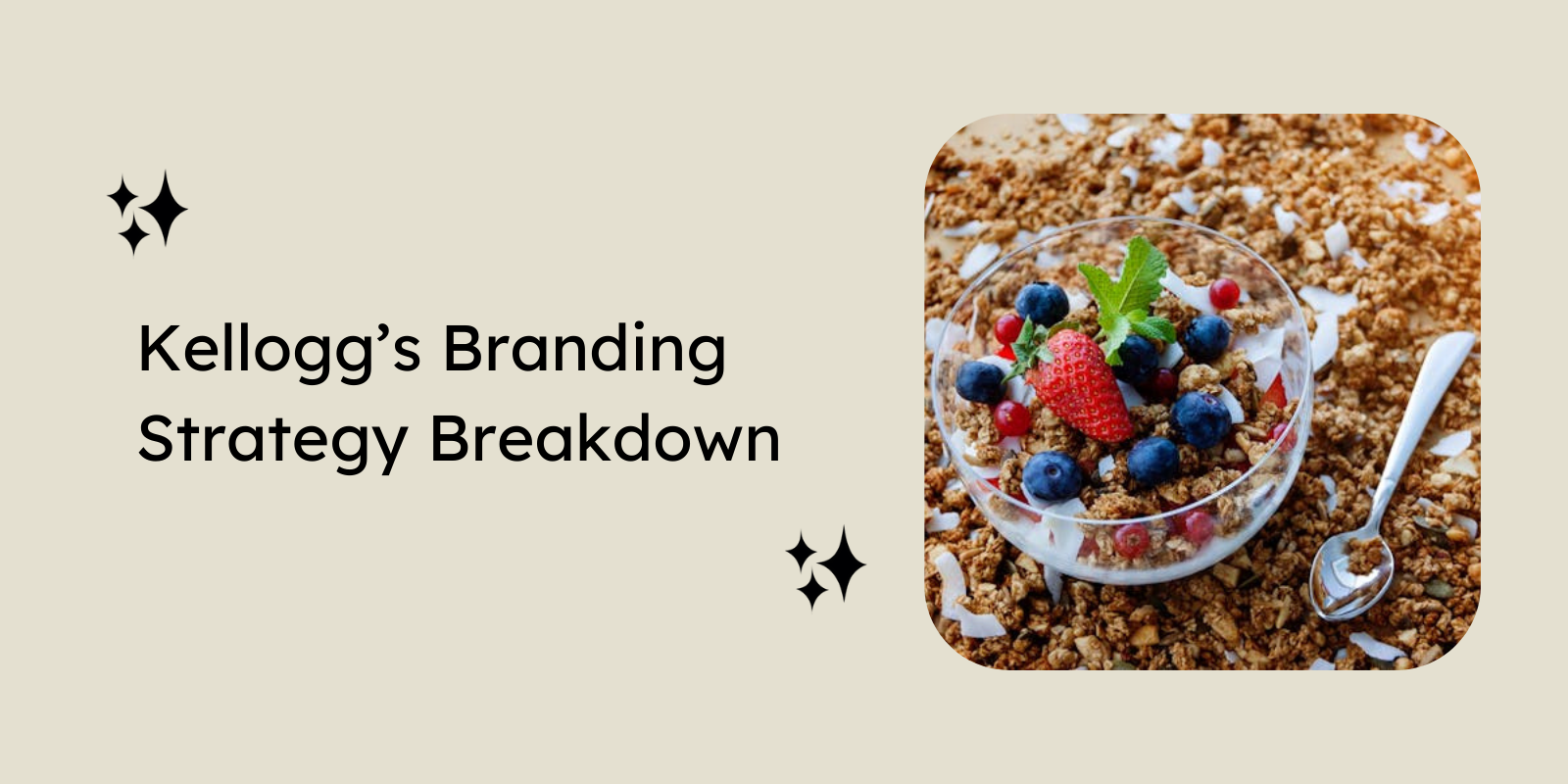This brand has something truly special—a legacy of turning breakfast into a global phenomenon. From the crunch of Corn Flakes to the nostalgic charm of Chocos, Kellogg’s has mastered the art of staying relevant across generations. But how did a simple cereal company become a household favorite worldwide? Through a mix of powerful branding, emotional storytelling, and strategic innovation, Kellogg’s has established itself as a leader in the food industry.
In this breakdown, we’ll explore the key branding strategies that have fueled its success, what makes Kellogg’s stand out, how it adapts to changing consumer preferences, and the lessons other brands can learn from its playbook. Let’s dive in!
About Kellogg’s
Kellogg’s, established in 1906, is a prominent player in the global breakfast food industry, with products available in over 180 countries. In 2024, the company reported net sales of $689 million for the third quarter, surpassing analysts’ expectations.
Kellogg’s maintains a significant presence in the U.S. cereal market, with a substantial market share. Its diverse portfolio includes over 50 brands, such as Corn Flakes, Frosted Flakes, Pringles, and Cheez-It.
The company has also committed to health trends by investing in plant-based and sustainable food innovations, though specific figures for this investment are not readily available. But what exactly makes Kellogg’s a branding powerhouse?
Kellogg’s branding strategy
Kellogg’s has built a brand that resonates with consumers, balancing tradition with modernity to remain relevant in a dynamic market. Let’s take a look at some key elements
1. Brand Identity
Kellogg’s has established a robust brand identity that emphasizes consistency, trust, and innovation, making it a household name worldwide.
- Logo designs and visuals
Since its inception, Kellogg’s logo has maintained its distinctive cursive script, derived from W.K. Kellogg’s signature, symbolizing authenticity and personal touch. The iconic red color has been a constant, representing energy and passion.
In 2012, the logo underwent a subtle refresh to modernize its appearance while preserving its heritage. This consistency extends to packaging, where the use of bright colors and clear branding ensures that Kellogg’s products are instantly recognizable on store shelves.
- Tagline and messaging
Kellogg’s communicates its commitment to family well-being through the tagline “Nourishing families so they can flourish and thrive.” This message underscores the brand’s focus on providing nutritious and high-quality products. Campaigns like “Share Breakfast” highlight Kellogg’s dedication to community and health, reinforcing trust and tradition among consumers.
- Brand personality
Kellogg’s brand personality is a blend of wholesomeness, family-friendliness, and innovation. The company offers a wide range of products catering to various demographics, from children to health-conscious adults.
For instance, Special K targets individuals aiming for weight management, while Rice Krispies appeal to children with their fun and playful image. This diverse product lineup reflects Kellogg’s adaptability and commitment to meeting consumer needs.
2. Value proposition
Kellogg’s has built a strong value proposition by offering nutritious, convenient, and affordable breakfast and snack options. The brand understands that modern consumers want quick, on-the-go meals without compromising on health.
That’s why Kellogg’s products strike a balance between taste and nutrition—whether it’s fiber-rich cereals, protein-packed snack bars, or fortified breakfast options.
Affordability is another key factor. While premium health brands often come with a hefty price tag, Kellogg’s makes wellness accessible to the masses. Its ability to innovate while maintaining cost-effective production gives it an edge in the competitive breakfast market.
This perfect blend of health, taste, and trust has solidified Kellogg’s position as a global leader in the food industry.
3. Positioning Strategy
Kellogg’s market positioning is built on trust, nostalgia, and innovation, solidifying its dominance in the breakfast and snack industry.
While General Mills offers household names like Cheerios and Nature Valley, its focus leans toward family-friendly and general wellness products.
Kellogg’s, on the other hand, balances indulgence (Frosted Flakes, Pop-Tarts) with health-conscious options (Special K, Kashi), ensuring relevance across demographics.
Nestlé, a global giant, competes with Kellogg’s in cereals but lacks the same deep-rooted breakfast identity in the U.S. market. Meanwhile, Quaker Oats commands the oatmeal space but doesn’t rival Kellogg’s broad portfolio spanning cereals, bars, and savory snacks.
Kellogg’s segmentation strategy is razor-sharp—Tony the Tiger keeps kids engaged, while Special K and RXBAR target health-conscious adults. The brand also localizes products, introducing region-specific flavors like green tea-flavored cereals in Asia.
4. Marketing and advertising strategy
Kellogg’s has been a breakfast staple for over a century, but its success isn’t just about cereal—it’s about smart marketing. Let’s take a closer look at how Kellogg’s has built a marketing and advertising strategy that resonates with today’s consumers.
Iconic marketing campaigns
Kellogg’s has mastered the art of creating campaigns that go beyond just selling cereal—they tell stories, spark engagement, and connect with people on an emotional level.
“Cereal and Milk” campaign
The “Cereal and Milk” campaign was a simple yet brilliant idea. It encouraged consumers to share their favorite cereal-and-milk combinations, turning an everyday breakfast routine into a conversation. The campaign featured celebrities and influencers showcasing their unique cereal pairings, creating a viral trend on social media.
People loved sharing their creative mixes, and Kellogg’s turned breakfast into a fun, interactive experience.
This campaign wasn’t just about engagement—it reinforced the idea that Kellogg’s is a brand that listens to its customers and celebrates the little joys of everyday life.
Nostalgia marketing & emotional storytelling
Kellogg’s knows that childhood memories are powerful. Many of us grew up with Tony the Tiger, Toucan Sam, and Snap, Crackle, and Pop. Instead of retiring these mascots, Kellogg’s has kept them relevant by giving them modern updates, using them in digital campaigns, and making them interactive.
The “Better Starts Here” campaign tapped into this nostalgia while promoting a healthier approach to breakfast. By highlighting whole grains, fiber, and lower sugar options, Kellogg’s reassured consumers that it understands their evolving needs while staying true to its legacy of making breakfast fun and delicious.
High profile collaborations
Kellogg’s has worked with some of the biggest names in food and pop culture to keep its brand fresh and exciting.
Chef collaborations & limited edition releases
Kellogg’s has partnered with chefs like Christina Tosi (founder of Milk Bar) to show that cereal isn’t just for breakfast—it can be part of creative, gourmet recipes. These collaborations have helped the brand reach a wider audience, including foodies and young professionals who might not usually think of cereal as an ingredient.
Limited-edition releases, like special flavors and collector’s edition packaging, create buzz and drive excitement. These tactics make Kellogg’s feel exclusive, even though it’s a household brand.
Social media & influencer marketing
Kellogg’s has fully embraced the digital world, using social media to keep its brand top-of-mind.
- Instagram & TikTok: Kellogg’s encourages users to share their cereal creations, making breakfast a social experience.
- Hashtag Challenges: By launching fun challenges (like #kelloggscerealfordinnerentry), the brand gets people talking and sharing.
- Influencer Partnerships: Collaborations with food influencers and wellness experts help Kellogg’s reach health-conscious consumers who may not have considered cereal as a nutritious option.
Purpose driven marketing
More than just a cereal brand, Kellogg’s has positioned itself as a company that gives back.
Mission Tiger: Supporting youth sports
The “Mission Tiger” campaign, featuring NBA star Ben Simmons, focused on funding middle school sports programs. This initiative aligned Kellogg’s with active lifestyles and community support, showing that the brand cares about more than just selling products.
This campaign wasn’t just feel-good marketing—it strengthened Kellogg’s connection with families and reinforced its values of health, fun, and togetherness.
Customer engagement & community building
Kellogg’s understands that today’s consumers want more than just a good product—they want to feel like they’re part of something bigger.
Through social media, loyalty programs, and interactive brand experiences, Kellogg’s has built a community around its products. Whether it’s nostalgic storytelling, influencer-driven campaigns, or purpose-driven initiatives, the brand continues to evolve while staying true to its core identity.
5. Product and innovation strategy
Kellogg’s has built its brand around iconic products like Corn Flakes, Froot Loops, Pringles, and Special K, each becoming household names over the years. To stay relevant, the company emphasizes health-focused innovations, introducing protein-enriched cereals and plant-based options to cater to the growing demand for nutritious foods. For instance, the Kashi brand focuses on whole grains and plant-based ingredients, appealing to health-conscious consumers.
In response to evolving consumer preferences, Kellogg’s has adapted by reducing sugar content in its cereals and focusing on sustainability. The company has also embraced plant-based protein foods, offering meat alternatives such as Morningstar Farms and Incog Meat, which are especially popular with vegan and vegetarian consumers.
6. Cultural impact and brand advocacy
From pioneering ready-to-eat cereals to normalizing quick, nutritious breakfasts, Kellogg’s played a key role in making cereals a global household staple. The brand didn’t just sell food; it sold a lifestyle of convenience, energy, and health.
Beyond the breakfast table, Kellogg’s has been a strong advocate for nutrition education and food security. Initiatives like “Better Days Promise” aim to provide nourishment to millions, addressing global hunger and promoting balanced diets. This commitment strengthens its brand trust and reinforces its role as a responsible industry leader.
Then, there’s the magic of mascots. Tony the Tiger isn’t just a cartoon; he’s a pop culture icon. From TV commercials to merchandise and even internet memes, he has kept the brand relevant across generations. These beloved characters help Kellogg’s maintain an emotional connection with consumers, proving that branding isn’t just about products—it’s about storytelling and legacy.
Key lessons and takeaways for your brand
Here are five key takeaways from Kellogg’s branding strategy for brands looking to build a lasting presence:
1. Stay consumer first
Kellogg’s constantly adapts to consumer preferences—whether through healthier options, new flavors, or convenient packaging. Your brand should prioritize market research and listen to customer feedback to stay relevant.
2. Brand consistency is everything
From Tony the Tiger to its signature red packaging, Kellogg’s ensures brand recognition across all touchpoints. Your brand should focus on maintaining a unified voice, visuals, and messaging to build trust and loyalty.
3. Marketing innovation drives engagement
Kellogg’s campaigns, from nostalgic ads to digital activations, keep the brand top-of-mind. Experiment with fresh, creative campaigns that resonate with their audience.
4. Purpose builds connection
Kellogg’s integrates social responsibility into its brand, like its “Share Your Breakfast” initiative. Aligning with meaningful causes can help your brand foster deeper customer relationships.
5. Adaptability is key
Kellogg’s continuously evolves—embracing digital trends, new dietary needs, and changing lifestyles. Your brand should remain agile and ready to pivot with shifting market demands.
Conclusion
Kellogg’s success isn’t just about selling cereal—it’s about building a brand that people trust and love. The company has stayed relevant for decades by listening to its customers, keeping its branding consistent, and embracing new marketing trends. For D2C brands, the lesson is clear: focus on what your audience wants, tell a compelling brand story, and stay flexible as the market evolves.
If you’re looking to build a brand that stands the test of time, take a page from Kellogg’s playbook. Need help crafting a strategy that connects with your audience?
Reach out to us today!




